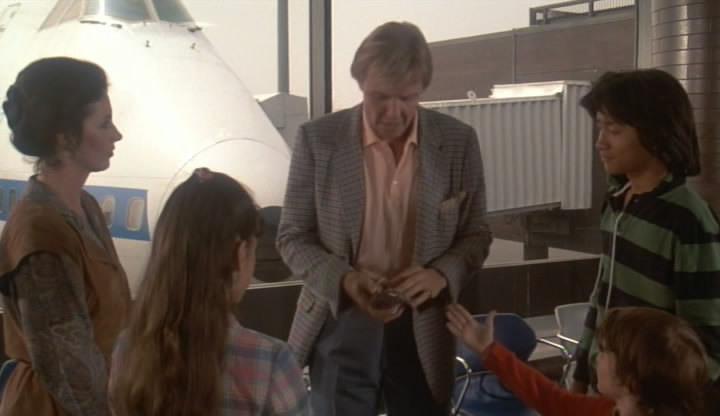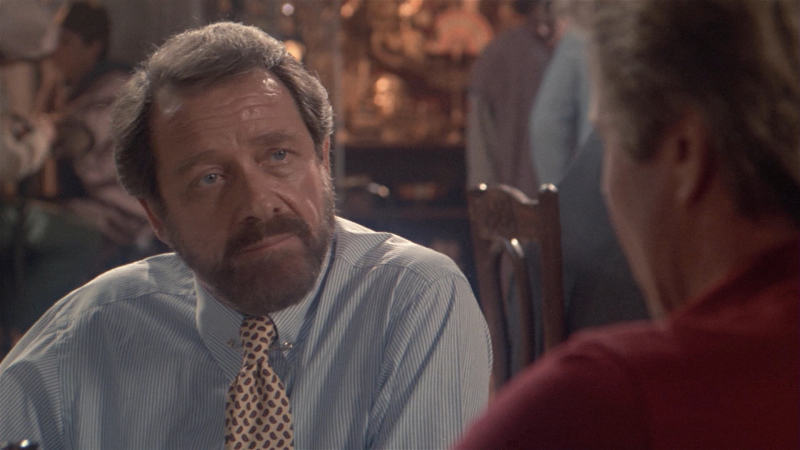Jon Voight Sets off to Sea With his Kids.
DIRECTED BY ROBERT LIEBERMAN/1983
STREET DATE: OCTOBER 18, 2016/KINO LORBER STUDIO CLASSICS
 There are two things that set Table for Five, a 1983 drama travelogue, apart from a run of the mill TV movie of the day: Exotic global travel, and cinematographer Vilmos Zsigmond. And perhaps a third, the presence of then-movie stars Jon Voight and Richard Crenna.
There are two things that set Table for Five, a 1983 drama travelogue, apart from a run of the mill TV movie of the day: Exotic global travel, and cinematographer Vilmos Zsigmond. And perhaps a third, the presence of then-movie stars Jon Voight and Richard Crenna.
The strained travels of the central family of the story, taking them to places as remote as the Roman coliseum and the pyramids of Egypt, is presented with a finely honed visual precision of the man who meticulously lensed Close Encounters of the Third Kind and The Deer Hunter. The film has an expertly muted, almost misty feel, which is presented well on this new blu-ray edition.
Table for Five tells the story of a divorced playboy (Voight) looking to reconnect with his three kids by dragging them on a cruise to Egypt. The movie is a draggy weepy that takes too long to get going, and waits too long in between its all-important Moments Of Truth. There are three children, the oldest being an adopted adolescent boy (Son Hoang Bui) who obsessively plays annoying handheld Atari games. When Voight threatens to throw the shrill, beeping game into the ocean was the only moment I was in agreement with his character. There’s also a mature-beyond-her-years daughter, played well by an awkwardly aged Roxana Zal, and the young boy played by Robby Kiger, who would go on to be in Monster Squad and Crazy Like a Fox. The kids are alright. At least for a while.
Watching Voight’s character step in it repeatedly and not even know it is not unlike watching a thick headed acquaintance in real life willfully screw up again and again.
Voight wants to reconnect with these three. Which is admirable at a glance, but he wants it to magically happen, as though arranging the trip is all he has to do. Watching this clueless and heretofore absentee dad justify making one selfish decision after another over the course of the two hour running time becomes almost unbearable in parts. Why “Table for Five” where there’s only four of them on the trip? It ain’t for Elijah. The extra seat is his hoped-for contingency, his “in” with any younger ladies on the cruise who might be looking for a seat. It’s a scheme that is immediately transparent to the kids, who internalize the effects of his behavior for the longest time.

Watching Voight’s character step in it repeatedly and not even know it is not unlike watching a thick headed acquaintance in real life willfully screw up again and again. Whatever growth the story yields the character is minimal. While not exactly movie escapism, this depiction does offer some boorish insight on the selfish center of male behaviors, and the conflicts that family brings. Eventually, when tragedy strikes at home, he’s forced to man up. Except, he can’t.
In Deliverance, it was up to Jon Voight to save Burt Reynolds. In Rambo III, Sylvester Stallone sets out to save Richard Crenna. In Table for Five, Richard Crenna arrives to save Jon Voight. Or more to the point, the poor kids. Crenna, not the usual “charisma vacuum” he’s been accused of being, plays Voight’s wife’s (Marie-Christine Barrault) current husband. He turns up in Egypt to break some shattering news to the kids, and take them home. The greatest testament to his and Voight’s professionalism that the film offers is witnessed in them valiantly plowing through the most tense sense in the film, a heated cafe chat about child custody. In striking high definition, it’s hard to miss the hundreds of flies amid their lips, their drinks, their eyebrows.

The film’s director, Robert Lieberman, has had a bountiful career episodic television, and dare I say, it shows. Table for Five is nearly all close-ups. The overuse of the close-up has become so prevalent, so epidemic in today’s media, that we don’t even know to be artistically offended by it. Rarely is emotional intimacy communicated by shoving a camera in someone’s face, or from an audience point of view, having the characters shoved into ours. Television, with its smaller screens and shorter running time, defaults to methods like close-ups as a cheap shorthand for just that, not to mention simply filling the frame. But a good filmmaker realizes how cinematically intrusive and powerful close-ups can be, and uses them sparingly. Case in point, the recent Hell or High Water, where the only close-up of the entire movie goes to Jeff Bridges in an essential moment of revelation late in the story.
Table for Five is nearly all close-ups. The overuse of the close-up has become so prevalent, so epidemic in today’s media, that we don’t even know to be artistically offended by it.
It’s hard to imagine anyone shelling out cash at the multiplex to see Table for Five in 1983 when the same payout could grant admission to Terms of Endearment or Tender Mercies. Or heck, Return of the Jedi or The Right Stuff. Of course, the film’s production company, CBS Films (no stranger to television) likely realized this, as this film and the handful of its other short lived theatrical offerings (including the more enjoyable Jamie Lee Curtis vehicle Grandview USA) were more likely green lit with the company’s burgeoning VHS market in mind.

Now, rightfully, Table for Five makes its way home once again. The deluge of close-ups may not be as glaring for many on the small screen, but Voight’s roughly handled parenting lessons cannot be overlooked, whatever the format. On blu-ray, everything is heightened. Somehow, that makes the wandering yet well intentioned Table for Five all the more confined. Who needs elbow room when it’s all giant heads, still struggling to communicate?
This Kino Lorber Studio Classics blu-ray edition of Table for Five includes no extras other than a few trailers. The film looks and sounds better than it likely has since 1983. For those who can appreciate a vintage TV movie drama on a cinema budget, this table is now available.
The images used in the review are present only as a reference to the film and are not meant to reflect the actual image quality of the Blu-ray.

